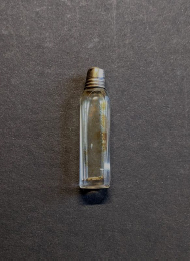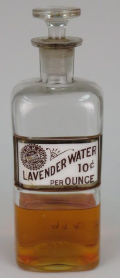By Angela Tillapaugh, Library Assistant

While exploring the collections of the MHS I came across a hand-blown glass perfume vial from the 19th century owned by Martha Catherine Codman Karolik. Upon seeing this, a question popped in my head- what kind of perfume would she have worn? I set out to discover what the most popular perfumes were in the late 19th century, that as a wealthy woman she would have likely been familiar with.
Prior to the mid to late 1800s in the United States, fragrances usually came in the form of “toilet waters”. Toilet waters were single note fragrances, diluted with distilled water or alcohol. These sorts of fragrances were usually sold in pharmacies, as fragrant oils were frequently added to cosmetics and medications.[1] Around the end of the 19th century, perfume from fragrance houses in Europe were imported to the United States. In Europe, France most notably, fragrance was considered an art form and a luxury product that was not relegated to being sold within pharmacies. The perfumes were heavier and more complex than the toilet waters, most using animalic ingredients like musk and ambergris that made them much more expensive. The influence of perfumes from overseas led to the emergence of American perfumers, usually with European names to capitalize on the association between Europe and luxury perfumes. An example is E.W. Hoyt of Lowell, who called his first perfume “Hoyt’s German Cologne” even though nothing about it was German. Other perfumers created a sense of luxury by creating increasingly elaborate bottles to house the fragrances, some bottles were worth more than the actual liquid.

The luxury status of perfumes, particularly those from France, made them popular with the wealthy. Wearing expensive perfumes would set people apart from the masses wearing light floral fragrances. As a young wealthy woman, Martha Catherine Codman Karolik likely would have been able to own these extravagant fragrances, which is what I imagine the vial above would have contained. I do not know exactly what perfume Martha would have carried in that small vial, but I imagine it was something powerful and interesting, sure to turn heads.
[1] “Fragrance.” Smithsonian Institution. Accessed May 10, 2021

